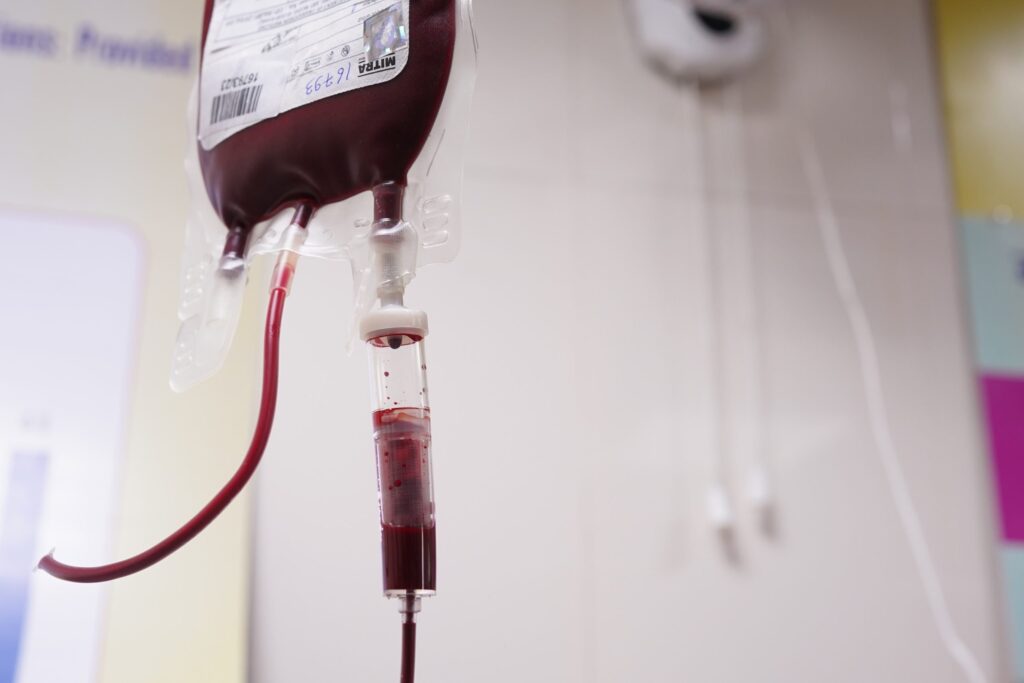
Who needs blood products?
- Blood products are typically indicated for patients that are hypovolemic, actively hemorrhaging, anemic.
How do you verify the patient for blood products?
- This process depends on your hospitals specific policies, but most facilities require a rigorous identification process by two nurses for the patients safety. The blood product is identified cross referencing the medication record, blood product information sheet that comes with the blood, and the blood unit itself. For this you are checking the patients name and birthday, blood type, expiration date, patients blood bank number. Lastly, the nurses will also check the blood product for any abnormalities in color and consistency.
What size IV and tubing do you use?
- Make sure you have a dedicated IV for blood product administration because many intravenous medications are not compatible with blood products! I like to use an 18g intravenous catheter for any blood transfusion in a stable patient. For trauma patients or for those in severe shock larger bore catheters can be used to help blood administer blood faster. Make sure to always use blood transfusion tubing with a Y infusion set and filter for blood products. The Y site allows you to prime your tubing with saline prior to blood administration and the filter helps to retain microaggreates or particles in the blood.
How fast and how long should blood products be administered?
- Rates depend greatly on the patient and the need for blood. When I administer blood I like to start the rate slower at about 75-100 mL/hr for the first 15 minutes to monitor for any reaction, then I increase the rate to 150 mL/hr or faster if necessary. For most adult patients the suggested rates according to the World Health Organization are as follows:
- Whole Blood at 150-200 mL/hr
- Packed Red Blood Cells 100-150 mL/hr
- Platelets / Plasma 150-300 mL/hr
- Blood products are to be used in a timely manner due to the increased risk of bacterial growth the longer they are out of refrigeration. A unit of blood should be infused in a maximum of four hours after removal from the fridge. Duration times for transfusions according to the World Health Organization are as follows:
- Whole Blood / Packed Red Blood Cells start within 30 minutes of removing from refrigerator and complete within four hours
- Platelets start immediately and complete with 30 minutes
- FFP start immediately and complete with 30 minutes
- Cryoprecipitate start immediately and complete with 30 minutes
What needs to be documented for the transfusion?
- Patient vitals (temperature, pulse, blood pressure, respiratory rate) need to be documented prior to administration, 15 minutes after starting the transfusion, and every hour afterwards until the transfusion has finished, then a final set of vitals 15 minutes after completion. However, you can always do your vitals more frequently if needed!
- Make sure to document the start and stop time of the transfusion, the volume of the blood product being transfused, unit number of the blood, the secondary nurse involved in the transfusion, and the patient consent to receiving blood products.
What are common adverse reactions to blood products?
- As a nurse you must watch closely for any reaction your patient may be having to blood as these can quickly lead to complications!
- A febrile reaction is most often characterized by fever, nausea, vomiting, and flushed skin.
- Hemolysis results from incompatible blood presents commonly with back pain, chest pain, respiratory distress, hypotension, tachycardia, or dark urine output.
- Allergic reactions can vary from itching and hives to anaphylaxis with respiratory distress.
- Septic reaction occurs due to blood contamination and results in fever, chills, nausea, vomiting, and hypotension.
What do you do if your patient has a suspected reaction?
- Stop the transfusion! This is the first and most important thing to do if a reaction is suspected, then disconnect the tubing and check all labels and product identification. Consult the medical provider to see if they want the rate to be slowed, any medications to be administered, or if they want the transfusion discontinued all together.
- Make sure to document any reaction findings in to the patient chart, including the patient appearance, vitals, symptoms, what time the reaction occurred, and how much blood the patient received when the reaction occured. Document your response and the providers response to the reaction.
- If the transfusion is discontinued send the unit of blood, blood tubing, blood samples for repeat type and screen, complete blood count, etc., and urine to check for hemoglobinuria to lab for investigation.
